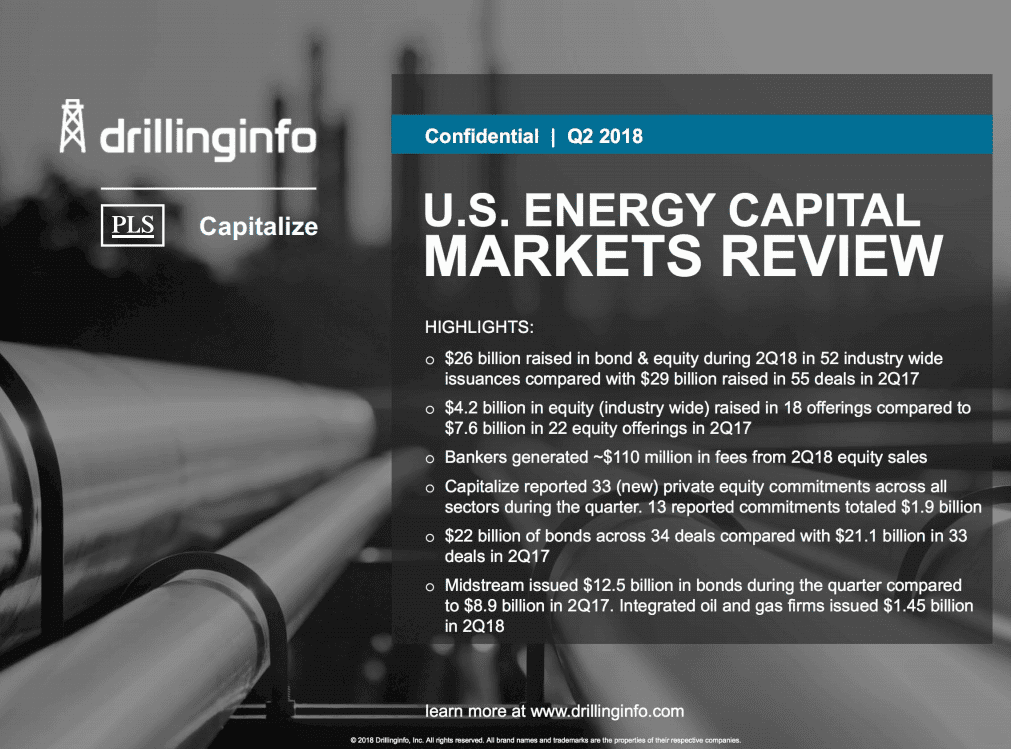Austin, TX – Drillinginfo, the energy industry’s leading SaaS and data analytics company, released its quarterly Capital Markets Review highlighting $26.1 billion in aggregate funds raised in the energy industry through underwritten public equity and debt offerings in Q2 2018. Though offerings fell nine percent year-over-year, the first half of 2018 boasted $65.5 billion in public securities. Slowing activity reflected movement to other investments, evidenced by increased tech sector weighting to almost 26 percent in the S&P 500 compared with energy’s 6.34 percent.
Key Findings from the U.S. Energy Capital Markets Review for Q2 2018:
- Investment grade issues comprised 53 percent of corporate energy bonds in Q2 compared to 29 percent in Q1.
- Public and private equity investment in the energy industry has slowed—45 percent less in public equity was raised during Q2 year-over-year.
- Lenders are less willing to make unsecured loans in Q2 than in prior four quarters.
Higher Credit Quality, But Less Bonds Issued Sequentially
The Capital Markets Review tracked a four percent year-over-year rise, but a 34 percent sequential drop to $22 billion for bonds sold by energy industry issuers during Q2. Additionally, Federal Reserve interest rate hikes kept some higher-risk, non-investment grade issues off the market. At 53 percent, investment grade issues comprised 18 of the 34 bonds offered in Q2 compared with 29 percent – or 15 investment-grade issues – out of 51 bonds sold in Q1.
Midstream, Upstream & Oilfield Services
- Midstream raised $12.5 billion across 17 bond issues (up 41 percent year-over-year, but down 24 percent sequentially in funds raised.)
- Upstream raised $5.7 billion via 12 bonds (down 45 percent year-over-year and 19 percent less sequentially.)
- Oilfield services (OFS) raised $1.5 billion from two bonds in Q2 (156 percent more year-over-year, but 72 percent less sequentially.)
For the first half of 2018, the industry sold $55.4 billion in bonds compared with $49 billion during the same period in 2017. Midstream raised $28.9 billion through 39 bond sales; upstream sold 23 bonds for a total $12.8 billion and oilfield services $7.3 billion through 13 offerings during the first half of 2018.
Equity Sales Continued to Wane
The industry raised $4.2 billion from public stock offerings during Q2, 45 percent less year-over-year and 34 percent below Q1. The quarter’s sole Initial Public Offering (IPO) was SPAC Pure Acquisition Corp., which raised $414 million in April. Q2’s meager IPO activity compares with nine IPOs in 2Q17 raising $3.7 billion and six in Q1 – all oilfield service firms that went public in mid-January to mid-February – to raise a combined $2.0 billion.
Midstream raised $1.33 billion from six issues, 61 percent year-over-year and 51 percent from Q1, as the Federal Energy Regulatory Commission (FERC) indicated in March its decision prohibiting Master Limited Partnerships (MLPs) from recovering income tax allowances in their expense allocations soured investors on the sector. Six upstream and five oil field service offerings during Q2 totaled $1.1 billion and $1.7 billion, respectively. Capitalize equity tracking for the first half of 2018 shows oil field services sold $4.2 billion through 17 offerings, ahead of both midstream with $4.0 billion across 12 issues, and upstream’s $1.8 billion through 11 issues.
Private equity firms, though aggressive investors since the 2014 price downturn, clearly pulled back in 2018. At the completion of Q2, Drillinginfo tracked 66 total private equity commitments to upstream, midstream, OFS and downstream, running at a 28 percent annualized shortfall.
Christopher George, director of Capitalize at Drillinginfo and lead author of the Capital Markets review stated, “The pace has especially slowed for new teams in upstream as sponsors struggle with exit strategies. Upstream commitments totaled 117 last year versus the 32 teams that we’ve tracked through the 2018 halfway point.”
